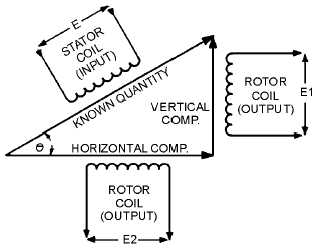4-9
Figure 4-7.—One example of resolution.
Similarly, the resolver has the ability to add two vectors that are at right angles to each other and
produce the resultant vector (hypotenuse) at the resultant angle. This is called COMPOSITION.
Figure 4-8 illustrates one use of a resolver in solving a composition problem. Assume that we have
two known quantities, vertical and horizontal components, that are represented by E1 and E2,
respectively. Each of these is fed to a stator coil. These two voltages induce a voltage, ET, in one of the
rotor coils. ET represents a voltage that is proportional to the hypotenuse. The voltage induced in the
other rotor coils is fed to a closed-loop servo, which positions the rotor shaft to the angle (direction) of the
hypotenuse.
Figure 4-8.—One example of composition.
Other mathematical solutions are possible to designers who apply resolvers in equipment. Typical
naval problems solved by resolvers involve distances, speeds, angular quantities, etc.
In most cases, as in figures 4-7 and 4-8, only resolver coils actively used in solving a particular
problem are shown in schematics.



